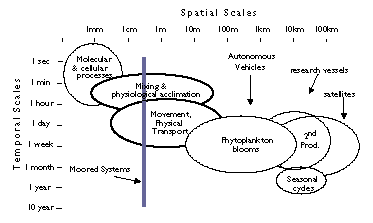Future Directions in Bioluminescence Research
UNCLASSIFIED WORKGROUP SESSIONS
Community Structure and Seasonal Patterns
Discussion Leader: Oscar Schofield
Bioluminescence patterns in nature reflect the overall planktonic community structure, which in turn reflects the synergy between a changing physical environment and the resulting biotic interactions. The rise of a species to bloom proportions (or bioluminescence significance) is directly related to the past history and current status of the physical, chemical and biological environment. Given the numerous feedbacks all of which can operate over many scales (from turbulent scales to vertical and horizontal transport), this is not a trivial task. This can require the researcher to understand the relative significance of small-scale non-hydrodynamic processes to patterns that are observed over larger scales. The same is true for the temporal domain, i.e. competition between species reflects the past and prevailing environmental conditions and the physiological capabilities of the individual species. This presents a scaling problem that requires understanding of the processes that occur over different scales of time, space, and organizational complexity (Levin 1992). Given these problems, defining the ecologically relevant scales is an important first major step, which will require a multiplatform sampling strategy (Figure below). Data collected by potential observation systems offer the possibility to define climatologies for bioluminescence patterns and the physical, chemical, and biological forcing functions.

This is critical to not only the basic research needs but is of direct naval relevance as any object moving through plankton-laden water has the potential to leave a luminous wake trail. To address the military needs efforts should focus on complementing the Navy’s ongoing focus to developing the capability for rapid environmental assessment and to forecast environmental conditions. This complements the strategy laid-out from the Oceanographer who suggested the Navy should direct efforts to "evolve a new emphasis on rapid characterization of the environment through direct application of real-time, in situ, and remotely sensed data into sensors, weapons, and tactical decision aids". To this end it was recommended that research efforts be directed to:
- Define the relevant space-time scales driving annual and/or seasonal climatologies of planktonic community structures and the corresponding bioluminescence at range of coastal sites. These sites should also to provide a range of model systems that are similar to likely operating environments for Navy. These sites should include a full suite of physical and biological observational capabilities coupled to regional physical/biological models. This effort might be achieved by leveraging off ongoing NOPP/ONR/NRL/NOAA efforts to develop adaptive sampling ocean observation systems and efforts to develop phytoplankton community models.
- Characterize the relative importance of episodic events in relation to overall seasonal and annual climatologies. It has long been recognized that episodic events can play a large role is structuring marine food webs. The biological signatures of these episodic events are often translated into significant biological signals (red-tides, gelatinous zooplankton blooms). Until the relative magnitude and importance of these events are characterized, annual climatologies will be highly suspect and subject to large uncertainty.
In order to reach these goals a series of long and short research goals were identified.
Short term goals:
- Bioluminescence detectors need to made available to the larger oceanographic community so they can be integrated into existing ocean observation systems. Therefore efforts should be directed to making affordable, intercalibrated and robust sensors to collect time series data in several ocean sites. Efforts should also focus on the biofouling concerns. The availability of instrumentation is key to defining bioluminescence climatologies, and provides a mechanism for adaptive sampling of episodic events. Once available, the systems should be integrated into existing multidisciplinary ONR/NRL research programs.
- Mine existing plankton databases existing in individual biological oceanography labs, and pool the data in a web-based data management system. Templates for web-based data management systems exist from ongoing ONR/NAVO efforts (cf. HYCODE report [external site]). The advantage of such a data system it would provide a first cut at seasonal climatogies for species compositions that would complement existing bioluminescence databases collected at discrete places at distinct times of the year.
- Models (see Workshop session) be constructed to use a bioluminescence data stream through data assimilation to initialize coupled physical/biological models and provide a range of militarily relevant data products.
- Assess how data streams from AUVs and satellites can be used to improve predictions of bioluminescence at a given place or time.
Long-term goals:
- Given that to a first order bioluminescence is dominated by dinoflagellates, develop a predictive dinoflagellate community model. The integrated system should combine the multiplatform observation datastreams and new generation dinoflagellate models.
- The integrated system should be run in a both a nowcast/forecast mode over militarily relevant scales (eg. predictions of 3-5 days). The forecast cycles would ideally be assessed in a series of predictive skill assessments experiments. This could be accomplished again in concert with joint academic/NRL efforts sponsored by ONR and NOPP.
- Generate a long-term time series to provide to quantify the temporal/spatial variability in the bioluminescence loads.
Next summary >>
[Download printable PDF version of this page]
 . | Return to SD Workshop Page. | Return to the Bioluminescence Web Page.
. | Return to SD Workshop Page. | Return to the Bioluminescence Web Page.